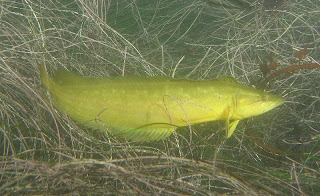 |
| Heterostichus rostratus |
Giant Kelpfish have very slender, blade-like bodies. This shape helps them to live among the sea grasses and remain camouflaged. They can come in a variety of reds, greens, and browns; this allows them to live in different types of grasses. They can even change their color, and females are better at performing this trick than the males.
The kelp forest habitat helps to hide the Giant Kelpfish from predators, but it also helps them to feed and breed. Hundreds if not thousands of species live in these forests, giving the Giant Kelpfish a smorgasbord of food choices. They eat fish, crustaceans, and molluscs.
IUCN Status : Not Listed
Location : Pacific Ocean off North America
Size : Length up to 2ft (60cm)
Classification : Phylum : Chordata -- Class : Actinopterygii -- Order : Perciformes
Family : Clinidae -- Genus : Heterostichus -- Species : H. rostratus
Family : Clinidae -- Genus : Heterostichus -- Species : H. rostratus
I have a report on the Giant kelpfish and this did not help me at all.
ReplyDeleteSorry to hear that :( Because there is only one writer, and because I write every day, I try and fit as much into these short posts as I can. You can often find more information by visiting the links within each article!
Delete